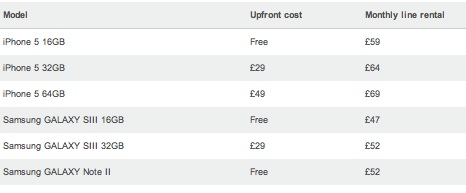Vodafone has introduced new tariff called Vodafone Red Hot that offers the latest smartphones on a rental basis.
Users that sign up to Red Hot will, in effect, sign one contract for usage, and another to rent a phone. They can then trade in the device when they fancy a new one. It’s a similar offer to O2’s offering, O2 Lease, that O2 launched in December 2011.
At the consumer level, Vodafone said this is attractive because it offers the chance to change your device every year without having to buy your way out of a contract, or negotiate a new contract.
It will mean that you have to keep your phone in good nick, of course, if you want a decent swap.

Although there are two contracts in the background, Vodafone is still offering rental plus usage as one integrated tarrif that includes unlimited calls to UK mobile and landlines, unlimited texts, 2GB internet plus 3GB UK WiFi for iPhone and 2GB UK WiFi for all other phones. At these prices, it looks as if Vodafone is trying to shorten its payback cycle on device susbidy, and in return offering consumers more device flexibility as a result.
Could an equipment rental model go further, though? Vodafone does, as it stands, provide T&Cs for the airtime contract and the hire contract as separate, so there is potential for a separation of the usage tariff from the device rental. It’s just that the operator has chosen to bundle the two together to the consumer. What if an operator didn’t?
As such, could the rental model provide scope for an interesting middle ground between fully subsidising devices and asking consumers to pay the price up front?
Interestingly, if operators take this model to the next level and actually separate out the usage tariff from the equipment rental tariff, if could offer a way to remove the assumption we have that if we want the best phone on contract, we must automatically have the priciest tariff plan.
In theory, if I’d love an iPhone 5 because I want iOS apps, and am a big iTunes and Apple user etc, or just want to swank a bit with the latest phone, but am not sure that my actual 3G usage will be that high, a lower data plan might suit me. So I’ll pay for the phone on the rental, but keep my monthly usage outgoings as low as possible.
Or it’s possible that I want a very high data cap, but am not too fussed about having the price of the latest, best device built into the plan when a workhorse mid-range Android device, say, could do the job just as well.
I think the nub of the matter is this – how can operators wean customers off massive device subsidies without punishing themselves and scaring customers? A rental model that decouples usage from device could be quite a smart way. It can be presented as increasing consumer choice, whilst the operator could, potentially, move to quicker customer profitability.
It’s worth reminding ourselves that users are tied into 24 month deals because they are given the phone at a vastly subsidised rate. If you get a €700 phone for free, then even at €50 per month it stands to reason that it will be 14 months before the operator has even earned back even the cost of giving you the phone.
This model means that you only become profitable to the operator pretty late on in the life cycle of your contract.
That’s a problem for consumers, because it ties them into a contract that limits their device choice for two years, unless they buy their way out. And it’s a problem for operators, too, because their cost of customer acquisition is so high.
Some operators have tried to get users off the subsidy heroin. Vodafone Spain tried it for a while but announced just recently that it would return to subsidising phones. The issue for any one operator is that if you are the only operator asking consumers to pay the full price of a device up front, they will tend to go to the operator that is asking for no lump sum, but higher monthly payments.
Of course, with a rental model there is still the front end subsidy for operators to swallow. But they will be able to defray that though their-trade in pricing, and keep high value customers on the network who may consider churning for a new device or offer from a rival operator.
As it stands, with a few phones available for a relatively high monthly fee, Red Hot may yet turn out to be luke warm in terms of consumer adoption. I think the effect will be that Vodafone shortens the time to a ROI on the device subsidy: a consumer pays more over the first year of a contract, but is rewarded by the prospect of a quicker upgrade. However, if the industry took this further, could there be potential in there for a different pricing model around smartphone delivery?



